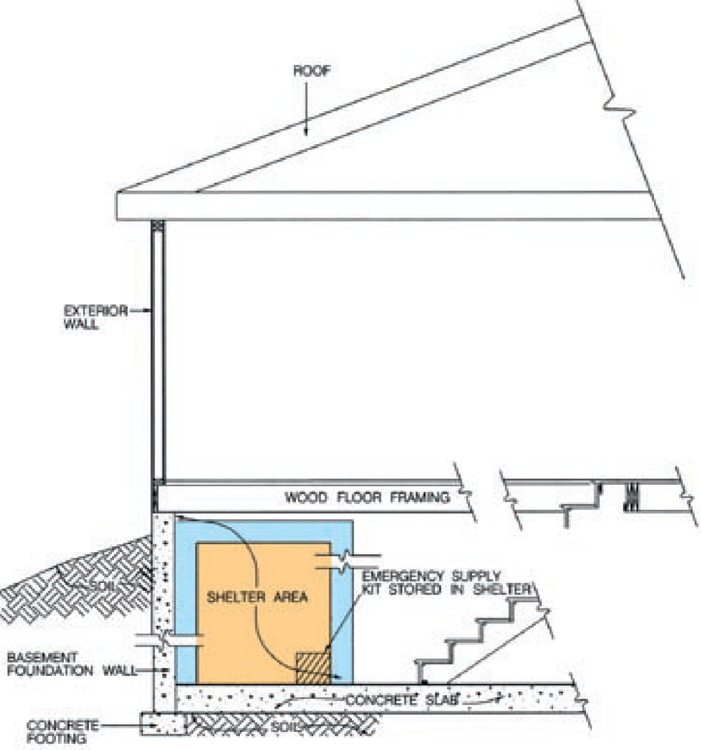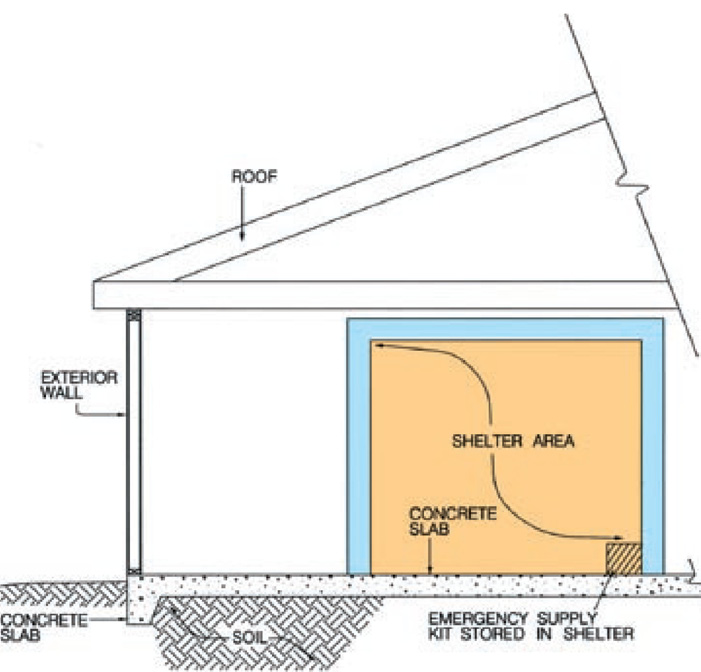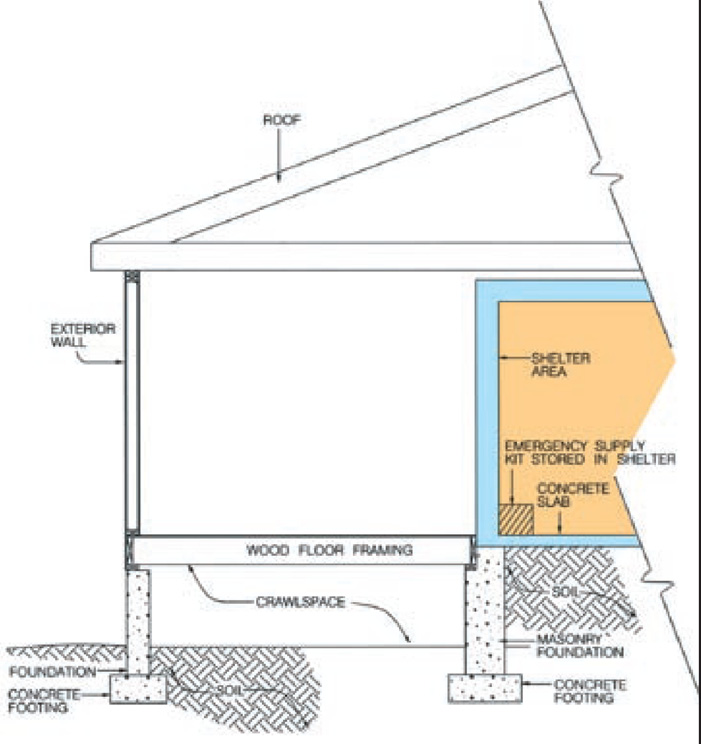Foundation Types
Houses on the following types of foundations are suitable for the installation of a shelter:
- Basement
- Slab-on-grade
- Crawlspace
A house on a basement foundation (see Figure II.2) is usually built on a foundation constructed of poured concrete or concrete masonry. Most concrete foundations are reinforced with steel bars or straps, but many concrete masonry foundation walls have no steel reinforcement. The framing for the floor above the basement is supported by the exterior foundation walls and sometimes by a center beam.
In a new or existing house with a basement, the shelter should be built in the basement.
You can build the shelter as an entirely separate structure with its own walls, or you can use one or more of the basement walls as walls of the shelter. If you use the basement walls, they will have to be specially reinforced. Typical reinforcement techniques used in residential basement walls will not provide sufficient protection from missiles. In new construction, your builder/contractor can reinforce the walls near the shelter during the construction of your house. Reinforcing the basement walls of an existing house is not practical.
The likelihood of missiles entering the basement is lower than for above ground areas; however, there is a significant chance that missiles or falling debris will enter the basement through an opening left when a window, a door, or the first floor above has been torn off by extreme wind. Therefore, your basement shelter must have its own reinforced ceiling; the basement ceiling (the first floor above) cannot be used as the ceiling of the shelter.
NOTE
The shelter designs in this booklet are applicable for any on-site construction. However, in a modular house, the shelter location would be limited to the basement or the belowground module. A modular house is a house constructed of modular units that have been built elsewhere, brought to the site, and installed on a permanent foundation.

The least expensive type of shelter that can be built in a basement is a lean-to shelter, which is built in the corner of the basement and uses two basement walls. The lean-to shelter uses the fewest materials, requires the least amount of labor, and can be built more quickly than other types of basement shelters.
In general, it is easier to add a basement shelter during the construction of a new house than to retrofit the basement of an existing house. If you plan to add a basement shelter as a retrofitting project, keep the following points in mind:
- You must be able to clear out an area of the basement large enough for the shelter.
- Unless the exterior basement walls contain steel reinforcement as shown on the design drawings provided with this booklet, these walls cannot be used as shelter walls since they are not reinforced to resist damage from missiles and uplift from extreme winds.
- Exterior basement walls that are used as shelter walls must not contain windows, doors, or other openings.
- The shelter must be built with its own ceiling, so that the occupants will be protected from missiles and falling debris.
A slab-on-grade house (see Figure II.3) is built on a concrete slab that is installed on compacted or natural soil. The concrete may be reinforced with steel that helps prevent cracking and bending. If you are building a new slab- on-grade house and want to install a concrete or concrete masonry shelter, your builder/contractor must make the slab thicker where the shelter will be built. The thickened slab will act as a footing beneath the walls of the shelter to provide structural support. It will also help anchor the shelter so that it will stay in place during an extreme wind event, even if the rest of the house is destroyed.
In an existing house, removing part of the slab and replacing it with a thickened section would involve extensive effort and disruption inside the house. Therefore, building a shelter with concrete or concrete masonry walls in an existing slab-on-grade house is generally not practical. You can, however, build a wood-frame shelter, because its walls are not as heavy and do not require the support of a thickened slab. A wood-frame shelter can be created from an existing room, such as a bathroom or closet, or built as a new room in an open area in the house, such as a garage.
You can also build a shelter as an addition to the outside of a slab-on- grade house. This type of shelter must have not only proper footings but also a watertight roof. Because a shelter built as an outside addition will be more susceptible to the impact of missiles, it should not be built of wood framing. Instead, it should be built of concrete or concrete masonry. Access to this type of shelter can be provided through an existing door or window in an exterior wall of the house.

In general, it is easier to add a shelter during the construction of a new slab-on-grade house than to retrofit an existing slab-on-grade house. If you plan to add a shelter to a slab-on-grade house as a retrofitting project, keep the following points in mind:
- The walls of the shelter must be completely separate from the structure of the house. Keeping the walls separate makes it possible for the shelter to remain standing even if portions of the house around it are destroyed by extreme winds.
- If you are creating your shelter by modifying a bathroom, closet, or other interior room with wood-frame walls, the existing walls, including sheathing on either the inside or outside of the walls, such as drywall or plaster, must be removed and replaced with walls and a ceiling resistant to the impact of windborne missiles and other effects of extreme winds.
- If you intend to build a shelter with concrete or concrete masonry walls, a section of your existing slab floor will have to be removed and replaced with a thicker slab. As noted above, this is usually not practical in an existing house.
A house built on a crawlspace (see Figure II.4) usually has a floor constructed of wood framing. Along its perimeter, the floor is supported by the exterior foundation walls. The interior part of the floor is supported by beams that rest on a foundation wall or individual piers. Crawlspace foundation walls may be concrete, but are usually constructed of concrete masonry. Crawlspace foundation walls are often unreinforced and therefore provide little resistance to the stresses caused by extreme winds.

Building a shelter inside a house on a crawlspace foundation is more difficult than building a shelter inside a house on a basement or slab-on-grade foundation. The main reason is that the entire shelter, including its floor, must be separate from the framing of the house. As shown in Figure II.4, a shelter built inside the house cannot use the floor of the house. The shelter must have a separate concrete slab floor installed on top of earth fill and must be supported by concrete or concrete masonry foundation walls. An alternative approach, which may be more economical, is to build an exterior shelter on a slab-on-grade adjacent to an outside wall of the house and provide access through a door installed in that wall.
Ventilation in the area below the floor of the house is also an important issue. The wood-framed floor of a house on a crawlspace foundation is typically held 18 to 30 inches above the ground by the foundation walls. The space below the floor is designed to allow air to flow through so that the floor framing will not become too damp. It is important that the installation of the shelter not block this air flow.
In general, it is much easier to build a shelter inside a new crawlspace house than in an existing crawlspace house. If you plan to add a shelter to an existing crawlspace house as a retrofitting project, keep the following in mind:
- The shelter must have a separate foundation. Building the foundation inside the house would require cutting out a section of the existing floor and installing new foundation members, fill dirt, and a new slab – a complicated and expensive operation that is often not practical.
- A more practical and more economical approach would be to build an exterior shelter, made of concrete or concrete masonry, on a slab-on-grade foundation adjacent to an outside wall of the house, as described above.
WARNING
You should not install a shelter in a house supported by piles, piers, or columns. With building connectors commercially available, there is no economical way to separate the shelter from the floor framing and ensure that the shelter will withstand the forces of extreme winds.
You may be tempted to build a shelter under a house on a pile, pier, or column foundation. However, if the house is in a storm surge area or other flood hazard area, the area under the house would be below the flood level. A shelter built in that area would trap its occupants in rising flood waters. See the warning on page 5 for more information.

